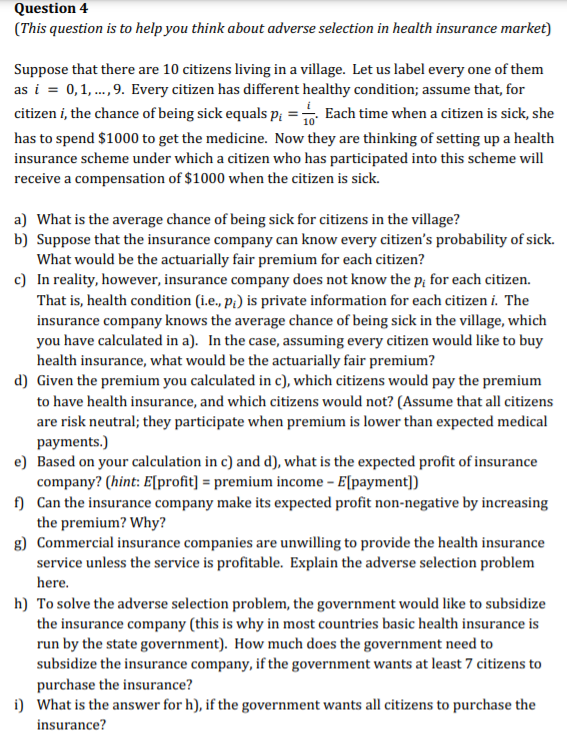
Question 4 (This question is to help you think about adverse selection in health insurance market) Suppose that there are 10 citizens living in a village. Let us label every one of them as i = 0,1, ..., 9. Every citizen has different healthy condition; assume that, for citizen i, the chance of being sick equals p: = Each time when a citizen is sick, she has to spend $1000 to get the medicine. Now they are thinking of setting up a health insurance scheme under which a citizen who has participated into this scheme will receive a compensation of $1000 when the citizen is sick. a) What is the average chance of being sick for citizens in the village? b) Suppose that the insurance company can know every citizen's probability of sick. What would be the actuarially fair premium for each citizen? c) In reality, however, insurance company does not know the p; for each citizen. That is, health condition (i.e., P.) is private information for each citizen i. The insurance company knows the average chance of being sick in the village, which you have calculated in a). In the case, assuming every citizen would like to buy health insurance, what would be the actuarially fair premium? d) Given the premium you calculated in c), which citizens would pay the premium to have health insurance, and which citizens would not? (Assume that all citizens are risk neutral; they participate when premium is lower than expected medical payments.) e) Based on your calculation in c) and d), what is the expected profit of insurance company? (hint: E[profit] = premium income - Epayment]) f) Can the insurance company make its expected profit non-negative by increasing the premium? Why? g) Commercial insurance companies are unwilling to provide the health insurance service unless the service is profitable. Explain the adverse selection problem here. h) To solve the adverse selection problem, the government would like to subsidize the insurance company (this is why in most countries basic health insurance is run by the state government). How much does the government need to subsidize the insurance company, if the government wants at least 7 citizens to purchase the insurance? i) What is the answer for h), if the government wants all citizens to purchase the insurance







